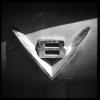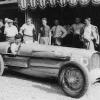Originally posted by WDH74
I probably have it backwards, but wasn't the Miller U-16 aero engine actually a license built Bugatti engine? I seem to recall reading about the technical advisors to the US military being given a lot of grief for trying to bring the engineers (who were German) back from Europe to help build the prototype.
I also remember reading about this engine's frailties-apparently the twin crankshafts would flex as revs rose, and eventually they'd meet. Destructively, needless to say.
But like I said, I prolly got this backasswards.
-William
The "U-16" Bugatti you are referring to was license-built in the US as the 'King-Bugatti", by none other than the Brothers Duesenberg in 1917-18, in Elizabeth NJ. At the time, Fred and August Duesenbergs had a number of engine designs to their credit, while Harry Miller was still primarily a carburetor manufacturer.
Bugatti's U-16 Aero engine was not noted for its success, it was far too heavy, and suffered from a lack of power. Duesenberg Motors, Inc., were able to reduce the weight considerably, and also increased the power output enough to satisfy the US War Department to order it in large numbers, but the war ended before many were produced. Even still, for something like 150 hp, this engine weighs in (at least according to the placard on the unit displayed at the Auburn Cord Duesenberg Museum in Auburn IN a few years back) at something like 1000 lbs (or just a bit heavier than an Auburn V-16 engine of 1931-33).
I believe the Lockhart 16 was a U-16 (two cranks, geared together) with the blocks angled slightly away from each other, due to the need for clearance of the two intake cams, and space for intake manifolding.
However, perhaps the earliest "U-16" in racing activity was the 1921 Duesenberg Daytona LSR car, which used two Duesenberg 300cid SOHC straight eights, geared together, but not with a common crankcase, IIRC, but rather just two straight 8 engines mounted side-by-side.
While of course, not racing engines, there were a few "odd duck" engines experimented with in early days: Ford, in the middle 20's, built an inline 5-cylinder flathead, years before anyone else even considered that arrangement, along with an X-8, two cylinders paired together, aircooled, 2 blocks on top, two on the bottom. Neither engine was particularly successful at the time.
In 1907, the Adams-Farwell car used a 5-cylinder rotary engine, mounted flat in the rear of the car, where the trunk or roadster turtle deck would be. Rotary piston engines had their crankshaft bolted to the chassis (or the firewall of the aircraft), and the crankcase & cylinders rotated around that, geared to whatever drive system was used (bolted to propellor on an airplane, as in the Sopwith Camel).
In 1931, Packard built an experimental straight-TWELVE engine, that's right, 12 cylinders all in a row. This engine, mounted in a modified Packard V-12 chassis, was driven on the road through the end of WW-II, when it was finally scrapped.
Oh well, odd engines, and odd cylinder counts.....
Art Anderson


























